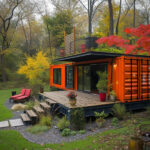Steel container homes present an innovative approach to residential construction, wherein steel shipping containers are repurposed into habitable structures. These homes are gaining popularity due to their affordability, strength, and modularity. Typically constructed from disused shipping containers, they come in sizes like 20 feet by 8 feet or 40 feet by 8 feet, with the potential to be stacked or combined for larger spaces. Steel container homes can range from simple, tiny houses to elaborate, multi-story residences.

The process of converting shipping containers into homes involves design considerations that ensure the structure adheres to building codes and meets living standards. While the containers themselves are relatively inexpensive, outfitting them for residential use requires insulation, plumbing, electrical work, and interior finishing. The allure of container homes also lies in their perceived sustainability, as repurposing steel containers for housing reduces waste and utilizes materials that are abundantly available.
Despite their simplicity, container homes can be equipped with modern amenities and customized to individuals’ preferences. The versatility of container-based architecture allows for creativity in design, offering solutions ranging from move-in ready luxury container homes to DIY projects that homeowners can finish themselves. They serve as a testament to the adaptability and potential for innovation within the housing market, reflecting a growing interest in alternative living spaces that challenge traditional construction methods.
Design and Customization
Designing and customizing a steel container home allows one to create a space that efficiently utilizes the compact nature of shipping containers while also catering to aesthetic preferences and functional needs.

Floor Plans and Layouts
Container homes offer a high degree of flexibility in floor plans and layouts. They can be arranged in various configurations, allowing them to be transformed into multi-story homes or spread out horizontally to provide various living spaces. For instance, the architectural versatility allows for designs that integrate natural light effectively throughout the living areas.
Doors and Windows
Incorporating doors and windows into the design of a container home is crucial for access and natural light. Choices range from full-height glass doors for maximizing views to strategically placed windows that enhance ventilation and natural light flow through the home.
Kitchen and Bathroom Design
The kitchen and bathroom design in a container home requires thoughtful planning to maximize utility within a compact space. Efficient use of vertical storage and built-in appliances helps conserve space in the kitchen, while in bathrooms, corner sinks and showers can optimize room for movement.
Exterior Finishing
Exterior finishing not only defines the overall aesthetic appeal of a container home but also contributes to its sustainability and durability. Choices for finishes include modern cladding materials, which can also improve insulation, and the use of large overhangs to provide shading and reduce energy consumption.
Types of Steel Container Homes

Container homes come in various configurations to meet different needs, from the DIY enthusiast to those looking for ready-made solutions. They leverage the durability of steel containers to create cost-effective, versatile living spaces.
DIY Container Homes
DIY container homes appeal to those who prefer a hands-on approach to their living space. These homes come in the form of basic steel containers that the buyer can convert into a habitat. Individuals often purchase a kit that includes the container and various customization options such as windows, doors, and interior finishes. It’s a project that allows for significant cost savings and personalization.
Prefab Container Homes
Prefab, or prefabricated, container homes are manufactured off-site and delivered ready for assembly. Companies like Kubed Living offer a range of styles and layouts, allowing clients to choose a home that fits their needs. Prefab models often include modern amenities and are designed for quick setup, making them a suitable option for those who want to avoid the complexities of a DIY project.
Modular Homes
Modular homes are larger than tiny houses and feature a design based on multiple container units. They provide the benefits of traditional housing, such as spacious living areas and multiple rooms, while still incorporating the mobility and robustness of modular homes construction. Backcountry Containers and Custom Container Living are known for crafting these substantial and customizable dwellings.
Tiny Houses and Studios
Tiny houses and studios utilize single or few containers to create compact and efficient living spaces. These versatile structures can serve as full-time residences or as supplementary spaces like offices or studios. The appeal of tiny houses is their minimal footprint and potential for placement on varied and sometimes remote locations.
Construction Details

When building a steel container home, attention to detail is critical. Specifics regarding codes, structural integrity, utilities, and construction methods are essential components that ensure the safety and longevity of the structure.
Building Codes and Permits
Adherence to local building codes is a prerequisite for constructing a shipping container home. These codes regulate design and construction standards to ensure safety. Prior to construction, obtaining the necessary permits is mandatory. It’s advisable to conduct thorough research or consult professionals to navigate zoning laws and building regulations, which can vary greatly by locality.
Foundation and Insulation
A robust foundation is crucial to anchor the container home securely. Options include concrete piers or slab foundations, depending on soil type and climate. Equally important is effective insulation, which can be applied internally or externally to maintain the home’s thermal envelope. Choices for insulation materials might include expanded polystyrene or closed-cell spray foam, each offering different performance levels and price points.
Plumbing and Electricity
Plumbing and electricity installation in a container home must conform to building codes and are typically completed by licensed professionals. While plumbing might involve innovative solutions to conserve space and water, electrical work often needs to be integrated carefully due to the metal composition of the container, which could pose risks if not properly insulated and earthed.
Welding and Fabrication
Welding is an integral part of container home construction, used in both joining containers and making structural adjustments. Fabrication is vital for customizing containers, creating openings for windows, doors, and room layouts. This requires skilled labor to ensure the structural integrity of the container is maintained throughout the modifications.
Material and Sustainability

Steel container homes are at the forefront of sustainable building practices, repurposing steel shipping containers into innovative living spaces. They’re celebrated for their eco-friendly nature and the potential for efficiency in their insulation and utility systems.
Steel Shipping Containers
Steel shipping containers serve as the primary building block for these homes. Their availability and strength make them ideal for construction. Every year, countless shipping containers are left unused; steel container homes recycle these robust structures, preventing additional waste and supporting sustainability in building.
Eco-Friendly Practices
Sustainable building encompasses eco-friendly practices, including the recycling of materials and reduction of construction waste. The steel container home industry significantly contributes by repurposing discarded shipping containers, reflecting a broader shift towards greener living. Their adoption lessens the environmental impact by mitigating the waste associated with traditional construction and the need for new raw materials.
Insulation and Utilities
Insulation is critical in making container homes energy-efficient. Methods like spray foam insulation create a tight envelope, increasing thermal resistance and keeping energy costs low. Utilities in container homes often employ sustainable features such as solar panels and greywater systems. These approaches complement the sustainable ethos of the container home concept, further supporting the goal of reducing the ecological footprint.
Cost Factors

The cost of building a steel container home can vary significantly based on several factors including the initial price of containers, construction expenses, and the ongoing cost of cleaning and maintenance.
Affordability and Price
Container homes are often considered a more affordable housing option. The initial price of a shipping container ranges from $1,200 to $10,000, depending on its condition and size. However, when one accounts for the cost of modifying these containers for habitation, the total price can escalate. While still potentially lower in cost than traditional homes, the affordability of a container home hinges on various choices such as size, design complexity, and finishes.
Construction Costs
The construction costs for container homes generally fall between $150 to $350 per square foot, which includes modifications such as insulation, windows, doors, and interior finishes. Specific expenses like wiring can cost approximately $1.56 to $3.75 per square foot, and plumbing needs may add more to the budget. These costs can accumulate, making it essential for buyers to carefully plan their budget ahead of construction.
Cleaning and Maintenance
The cleaning and maintenance of a shipping container home involve both routine upkeep and addressing the wear and tear on its steel structure. Corten steel, used in shipping containers, is designed to weather well, but regular maintenance is necessary to prevent rust and degradation over time. The cleaning of the home must also account for the unique aspects of the container’s design, potentially influencing long-term maintenance costs. Moreover, managing waste effectively during the construction process can minimize environmental impact and reduce extraneous expenses.
Advantages of Container Homes

Container homes offer a unique set of benefits that cater to individuals looking for sustainable, cost-efficient housing solutions. These steel structures, repurposed for living spaces, provide remarkable durability and versatility, alongside advantages in scalability and portability.
Durability and Versatility
Container homes are built from weather-resistant steel that has been engineered to endure the demanding conditions of international shipping. This inherent durability means they are designed to withstand harsh environments, offering a sturdy and long-lasting housing option. Their versatility is equally impressive; these containers can be modified into a wide range of architectural designs, catering to various aesthetic preferences and functional requirements. They can serve not only as homes but also as offices, workshops, or off-grid retreats, demonstrating their multifaceted applications.
- Durability: Robust steel construction resists environmental pressures.
- Versatility: Architectural adaptability for diverse design possibilities.
Scalability and Portability
One of the remarkable advantages of container homes is their scalability. They can be easily combined or stacked to create larger living spaces, or even expansive complexes, with relative ease compared to traditional construction methods. These modular units can grow with an owner’s needs, allowing for additional space to be added when required. Moreover, container homes are inherently portable. They can be transported to different locations, which is particularly advantageous for individuals who require or desire the ability to relocate their home with minimal disruption.
- Scalability: Modular design facilitates expansions or reductions in size.
- Portability: Ease of transportation to various locations.
Challenges and Solutions

Crafting a home from shipping containers involves dealing with unique hurdles and finding innovative fixes. The process mandates adherence to building codes and an astute consideration of the inherent space and size confines of the containers.
Space and Size Limitations
Standard Size: Shipping containers typically come in two sizes – 20 feet by 8 feet or 40 feet by 8 feet. This standard size provides a limited blueprint for design, often requiring additional planning to ensure that the space meets the homeowner’s needs.
Solutions:
- Modular Design: Utilize multiple containers in a modular fashion to create larger, more flexible living spaces.
- Creative Floor Plans: They can adjust the interior design to maximize space, including foldable furniture and multi-use fixtures.
Customization Constraints
Building Code: Adherence to local building codes can present constraints when customizing a container home. These regulations can affect everything from insulation to electrical work, impacting the project timeline and budget.
Solutions:
- Expert Consultation: Involvement of engineers and architects who specialize in shipping containers ensures that customized modifications meet all codes and regulations.
- Prefabricated Options: Companies like Honomobo offer customized container homes built to code, reducing the complexity for the buyer.
In the realm of container homes, limitations must be ingeniously tackled, turning challenges into opportunities for personalized and sustainable living spaces.
Living in a Steel Container Home

Living in a steel container home offers an affordable option with ample living space that can include a home office, multiple bedrooms, and even extend to two-story structures. Residents enjoy a fusion of style, functionality, and sustainability.
Living Area and Private Spaces
In a steel container home, the living area often showcases a modern, open-concept design, maximizing the use of space within the container’s bounds. Homeowners can typically expect a seamless flow between the kitchen, dining, and lounge areas. Private spaces such as bedrooms are ingeniously designed to maximize privacy and comfort. Even within the compact footprint of a container, architects can design homes with multiple bedrooms, sometimes across two levels in a two-story home setup.
Incorporating a home office is becoming increasingly common in container home designs. With the rise of remote work, these homes can often accommodate a dedicated workspace, which can be as simple as a compact nook or as elaborate as a fully outfitted office room.
Patio and Outdoor Extensions
Patios and outdoor spaces add value to steel container homes, extending the living space beyond the container’s interior. Homeowners can enjoy outdoor living areas that blend with the home’s aesthetic, creating a seamless indoor-outdoor transition. These areas range from basic wooden decks to expansive patios with features like outdoor kitchens and fire pits, often surrounded by landscaping that enhances the connectivity to nature.
Moreover, container homes offer the flexibility to create multi-functional outdoor extensions. They can effectively utilize vertical gardens, sustainable materials, and innovative designs to maximize outdoor space, whether it’s a cozy balcony or a sprawling deck, providing an affordable solution to those desiring a slice of outdoor sanctuary.
Professional Services and Resources
The construction of steel container homes is supported by a network of professional services and resources tailored to meet the design and construction needs. These services range from specialized container home builders to comprehensive DIY support systems, ensuring a streamlined design and build process for both prefab and custom designs.

Container Home Builders
Container home builders offer expert solutions in container architecture, transforming cargo ships’ durable steel boxes into innovative living spaces. Companies like PSE Consulting Engineers, Inc. specialize in sustainable shipping container homes, while Backcountry Containers provides customized options tailored to an individual’s design preferences.
Contractors and DIY Support
Contractors experienced in container home construction are crucial for ensuring the structural integrity and livability of these unique dwellings. For the DIYers, resources such as American Steel Structures provide guidance on building a container home from the ground up, offering support from the initial concept to the final construction stages.
Design and Build Process
The design and build process of shipping container homes involves meticulous planning and execution. With an emphasis on sustainability and customization, Ceed Civil Engineering caters to clients seeking a personalized container home, guiding them through the intricacies of the build process. Prefab shipping container homes streamline this process further, allowing for quicker build times and often a more cost-effective solution.









